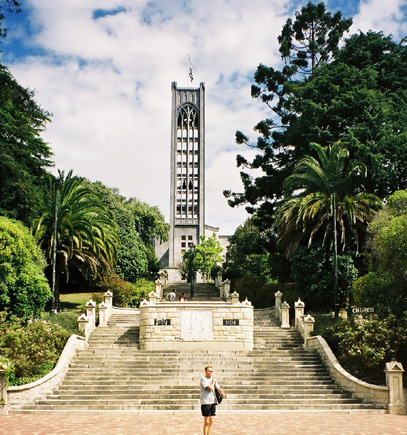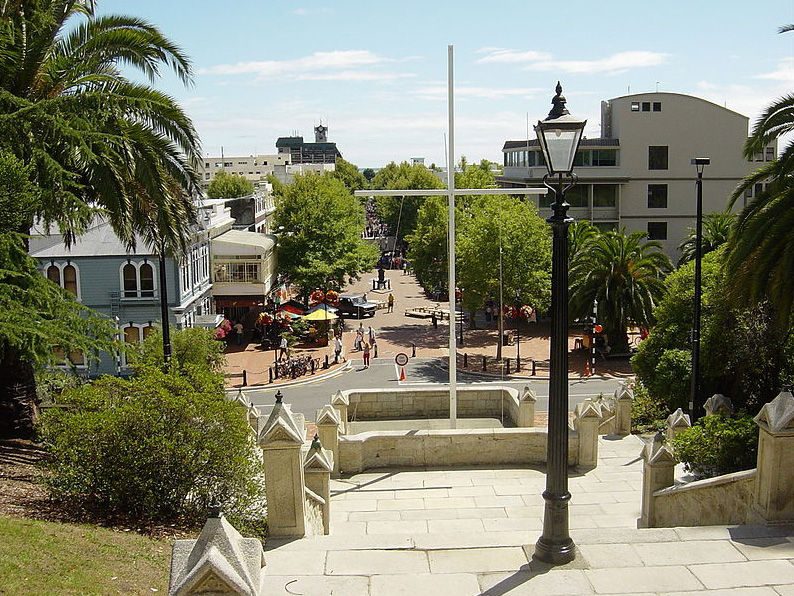Gifted to the city of Nelson in 1913, the Church Steps are one of just two surviving structures made from Tonga Bay granite, New Zealand's only true granite. Built on the northern face of Cathedral Hill, the steps are situated in the heart of Nelson. The hill, also known as Pikimai by the local iwi, was originally occupied by a fortified pa. In 1841 the hill was selected by Captain Arthur Wakefield as the centre of the new town of Nelson and administrative buildings were erected upon it. In 1843 it was fortified against a Maori attack after 20 settlers were killed during a dispute over land between New Zealand Company Surveyors and local iwi. During this period, people scaling the hill to enter the fortress created a dirt path now covered by the Church Steps. The anticipated attack failed to materialise and in 1848 Cathedral Hill was transferred to the Church of England. Ten years later, in 1858, the Nelson Board of Works constructed three flights of wooden steps over the site of the original dirt path. The steps were intended to provide access to 'Christ Church', the first Nelson Cathedral, which was completed two years later. Concerns were raised in 1905 about the safety of the 47-year-old steps. The following year it was suggested that new steps be erected in honour of the memory of Albert Pitt, a Nelson Member of Parliament and former Attorney General. Funds were raised for the project but it was eventually abandoned in favour of a memorial gate. In 1912, local businessman and noted philanthropist Thomas Cawthron [1833?-1915] made an unsolicited offer to the Nelson City Council to provide the funding necessary to enable the steps to be constructed. Cawthron selected granite as the appropriate material for the steps and noted that he wanted the steps to be 'a real good job, massive and ornamental'. While the majority of the granite used in New Zealand buildings is imported, at the time the new steps were commissioned a quarry had recently opened in nearby Tonga Bay, part of what is now the Abel Tasman National Park. The quarry contained New Zealand's only true granite and was used experimentally in a number of buildings throughout the country. The granite, which features large crystals of transparent quartz, does not weather well and, apart from the Former Public Trust Building in Wellington, all of these buildings have now been demolished. When Cawthron employed Wellington contractors to supply the light, cream-coloured granite for the Church Steps, he was under the impression that the material tended to harden upon exposure to the sun. The City Engineer, J. G. Littlejohn, and local architect Arthur R. Griffin prepared plans for a bold and ornate set of civic steps in 1912. Constructed by labourers employed on a daily basis, the Church Steps consisted of six, formal flights of steps that rose to a height of 11.5 metres up Cathedral Hill and led towards the Cathedral. The first flight of stairs swept up from two ornamental pillars and tapered in towards the first landing. To break the stiffness of the structure, the steps were divided twice into two flights on the ascent towards the Cathedral by decorative gardens. The upper balcony featured a plaque of grey, Aberdeen granite that commemorated Thomas Cawthron's donation to the city. Low walls of rusticated granite formed a barrier on either side of the steps. These walls featured decorated pillars that rose 1.5 metres at the corner of each flight. Completed in 1913, the steps cost £1887 and were formally opened by the Governor, Lord Liverpool, later that year. The Church Steps became an immediate focus for Nelson's civic and public activities. In 1942 they formed an integral part of the Centenary Celebrations. To mark the Celebrations the decorative gardens were replaced with viewing balconies. The lower balcony was adorned with a marble relief plaque depicting early settlers and included an inscription that noted that the hill was dedicated in memory of the settlers one hundred years after the founding of Nelson. The strength of public feeling for the Church Steps was reconfirmed in the early 1990s when they were protected from a proposed alteration by a publicly voiced protest and petition. The Church Steps in Nelson have national significance as a rare remaining example of a structure built from New Zealand's only true granite. Created almost entirely from the material, the steps are a highly public illustration of the colour, quality and properties of Tonga Bay granite. The granite enhances the aesthetic value of the steps, which were skilfully constructed and serve as an excellent example of stone masonry. The steps serve as a memorial to Thomas Cawthron, a notable Nelson resident, and have considerable significance as the site chosen to commemorate the centennial of Nelson. The site on which the steps are built add to the wider historical significance of the structure, which serves to symbolise the use of Pikimai, Cathedral Hill by Maori and Pakeha.



Location
List Entry Information
Overview
Detailed List Entry
Status
Listed
List Entry Status
Historic Place Category 1
Access
Able to Visit
List Number
253
Date Entered
9th September 1989
Date of Effect
9th September 1989
City/District Council
Nelson City
Region
Nelson Region
Extent of List Entry
Extent includes part of the land known as Legal Road, Nelson Land District, and the structure known as Church Steps thereon. Refer to the extent map tabled at the Heritage List/ Rārangi Kōrero Committee meeting on 29 October 2020.
Legal description
Legal Road, Nelson Land District
Location Description
Located on the north side of Cathedral Hill at the end of Trafalgar Street
Stay up to date with Heritage this month
